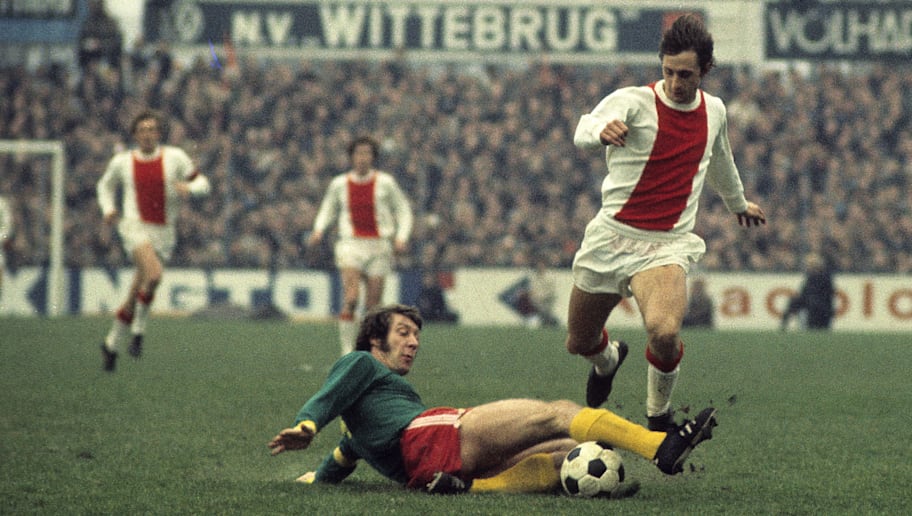
Vague, grey and undefinable, no position in the history of football has gone through as many identity shifts as the enigmatic No.10.
It's a tactical anomaly, a liquid role in a sport historically rooted in tactical structure, changing its form like a chameleon depending on the needs of the game at the time. Compare Johan Cruyff or Diego Maradona with Steven Gerrard or Frank Lampard and you'll find few similarities, except that, at one point, all have defined what it means to be an attacking midfielder.
The common thread is one of creativity. Whether it be dropping into the hole to drag central defenders out of space or rampaging into the box with a late run to attack a cross, the function of the attacking midfielder has always been to make things happen in front of goal by whatever means necessary.
Anyone lucky enough to watch Ajax, Barcelona or the Netherlands over the 1960s and 70s might point out that Cruyff was usually charged with leading the line, but while that might logically rule him out of contention as one of the great pioneering No.10s, it's possible that the modern attacking midfielder would not exist without Cruyff first changing what it means to be a forward.
So revolutionary was Rinus Michels' deployment of Cruyff as a forward who freely roamed the pitch, dropping into midfield or drifting wide depending solely on where he could get on the ball, that it instigated a tactical revolution that reached every corner of the game. As Ajax adapted their game to Cruyff, creating a fluid approach to football that saw every player but the goalkeeper move between positions, Total Football was born, and Catennacio - the predominant Italian system of the time - was a thing of the past.
With Cruyff, coaches began to see the benefits of deploying a player between midfield and attack. The options it provided in possession were endless, and the great teams of the years ahead were often defined by the players fielded 'in the hole.'
Bayern Munich, Liverpool and Juventus all famously won European cups featuring wildly different iterations of the No.10; Liverpool's Kevin Keegan was practically a second striker while Michel Platini of Juve and Ruud Gullit of Milan took far more nuanced approaches, but it was clear that the day of sweeper-oriented three-defender formations, and the traditional 4-4-2, were fading.
The teams who still played without any connecting player between midfield and attack, such as the previously dominant Inter and Real Madrid, embarked on long periods without substantial European glory, and it wouldn't be until the rise of the modern 10 that they would return to their respective pedestals.
? Coaches who have won the Treble
— Globe Soccer Awards (@Globe_Soccer) June 23, 2020
Sir Alex Ferguson | Man United, 1999
Josep Guardiola | Barcelona, 2009
José Mourinho | Inter, 2010
Jupp Heynckes Bayern, 2013
Luis Enrique | Barcelona, 2015 pic.twitter.com/gk1T7dgbM7
After the turn of the century, the attacking midfielder began to become more and more clearly outlined within tactical systems. 4-4-2 gave way to 4-2-3-1, a system built, for the first time on paper, around the technically proficient nucleus of midfield.
Now that the attacking midfielder was a role in itself rather than a central midfielder with instructions to attack or a striker tasked with dropping deep, it had an identity, and it became fashionable. Mesut Ozil of Real and Wesley Sneijder of Inter were suddenly the sexiest players in football,
Sneijder, in particular, was Cruyff re-defined, as the intrinsic Dutch association with the role continued into a new age. Possessing all the same subtlety, intelligence and creativity, he was deployed by José Mourinho behind Diego Milito and Samuel Eto'o to monstrous success as Inter reclaimed their crown as Europe's dominant team. Over in the Premier League, meanwhile, Liverpool and Chelsea had crafted quintessentially English takes on the role, as Steven Gerrard and Frank Lampard offered a more direct, physically imposing threat between the lines.
Now the role of the 10 was labelled, however, it became the thing to stop. The conundrum of how to protect defences against the creative geniuses who were taking over modern football was mulled over by the great footballing minds, and it was Pep Guardiola - setting up Barcelona with a contemporary take on Cruyff's Total Football - who cracked it.
The solution was simple. Guardiola's attacking midfielder dropped into a flat midfield three, which allowed one player to drop into the space usually earmarked for the likes of Sneijder and Ozil. This, when executed, nullified the threat, while leaving the defensive midfielder with four options - his midfield team-mates and his two central defenders - immediately open to him upon winning the ball.
The responsibilities previously attributed to the 10 in this system were shared. Andres Iniesta and Xavi were freed up to provide creativity high up the pitch, while Lionel Messi, in a circle back to the role Cruyff made famous, took on the function of a false 9, dropping into midfield to create the same logistical problems once tasked to your traditional attacking midfielder.
This was a system which twice got the better of Sir Alex Ferguson in Champions League finals, and resulted in the gradual phasing out of the clearly defined No.10 we see happening today.
? | Liverpool under Jurgen Klopp:
— The Anfield Buzz (@TheAnfieldBuzz) June 25, 2020
Most appearances: Firmino (229)
Most minutes: Firmino (17504)
Most goal involvements: Firmino (128)
Most assists: Firmino (51)
Most games won: Firmino (139)
And now Premier League winner: Roberto Firmino. ? pic.twitter.com/mIILJv34qw
In the history of football, dominance has always belonged to the team who can most creatively utilise the attacking midfielder. We're seeing that even today, with Liverpool's hybrid enigma Roberto Firmino the most effective modern example, but it's a role which, by its nature, is constantly changing with the times.
For more from Robbie Copeland, follow him on Twitter!
Source : 90min

